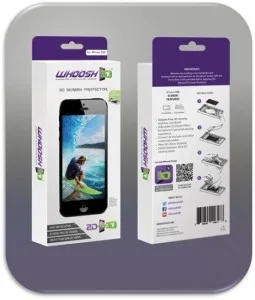In my previous article, Whoosh. There it is!, I introduced both the value proposition and functionality behind a new product, Whoosh3D. In short, this solution is a three-pronged offer: an autostereoscopic 3D app; a 3D-enabled screen protector/anti-glare overlay for smartphones, tablets and iPads; and a screen installer. (The screen protector can serve as a permanent attachment to a mobile device.) In the preceding article, I mentioned that Whoosh3D had its eye on reaching the education market in the near future. With an actual product in my hands, I have been putting Whoosh3D through its paces, evaluating its usefulness in the classroom – from an educator’s perspective. In this installment, I weigh in on the effectiveness of this tool and explore its potential for the education marketplace, its fit for education. I begin with two questions:
Does it perform as stated?
Yes. The functionality is there. The autostereoscopic 3D is there. The 3D display looks good. The app is easy to use and surprisingly adjustable. And it works on my own device.
Is it a Fit for Education?
Again, the answer is a strong yes. After much thinking, playing and more thinking, here are five reasons why Whoosh3D makes sense in an education setting and may hold a bright future:
It works on mobile devices. BYOD is a popular meme in education today. Every student, every school district, every university has their ‘preferred’ mobile device. Whoosh3D starts with the user’s preferred device and provides functionality from there. Simon Gemayel, the founder of 3DMe, explains the strategy in this way: “My group has always believed that 3D should have been introduced to the consumer mass market through glasses-free mobile devices rather than TVs and expensive displays requiring special glasses”.
It’s a threefer. Everybody loves a “threefer”: that is, getting three things for the price of one. This is particularly true of education customers. Educators will be delighted in the fact that, for one price, they can solve three problems: they get an anti-glare filter, screen protection for their mobile displays and autostereoscopic 3D.
The price is right. Did I say I get all the above tools for around the $29.99 to $59.99 price point, depending upon device size? Price-sensitive education customers will definitely appreciate that. Gemayel suggests, “My experience is that the majority of people (that I have met), like 3D and [really want] a 3D solution which is affordable and glasses-free”.
Negative parallax. The negative parallax on Whoosh3D is good – and adjustable. That’s important. The user can tone it down or ramp it up. Typically, educators want negative parallax toned up, for educational advantage. Whoosh3D gives them the flexibility to easily do so.
It’s a slam dunk for user-generated content. It is my estimation that the strongest advantage of the Whoosh3D autostereoscopic display lies with the app’s ability to produce user-generated stereo content. A built-in feature of the Whoosh3D app, this feature enables students to record their own world in 3D and then view, share, rinse and repeat in autostereoscopic 3D. As an educator, I would use this feature immediately and creatively.
The Weakest Link
Anne Bronte once said: “There is always a “but” in this imperfect world”. This holds just as true with my analysis of Whoosh 3D’s fit for education. The challenge is this: one cannot reach educational customers with new technology without showing them superlative educational content running on that technology. What is missing is the connection to the educational customer, that mouth-watering, irresistible, “this solves my pain” learning content. Content that leverages the new technology in a way that creates an “I cannot ignore this” customer experience. Without killer educational content to show, it becomes a much harder sell. Yet, it is not Whoosh3D’s fault that such content is currently not available on its device. I know the company has being trying to court educational 3D content providers. But I sometimes wonder why 3D educational content manufacturers don’t really want to sell their software or learning objects and why content makers don’t want to work more advantageously with symbiotic partners. Which is more important: making 3D content (because it’s cool) or selling 3D content (because I can make a business out of it)? Stumps me.

Some Concluding thoughts
In an exploding educational market of 1:1 and BYOD technologies, Whoosh3D certainly offers a strong fit for education. Gemayel of Whoosh 3D understands that, strategizing: “We have not built business sandcastles which are solely dependent on one application, industry, or consumer. For this reason we have invested heavily in features which can be used by students (viewing educational content and working with 3D printers now making their way into schools), gamers, architects, medical practitioners and more”. And with over 36 worldwide educational 3D (eS3D) content providers now hammering out stereo content, it should not take Whoosh3D long to find a suitable content “plus one.” While Whoosh 3D finds impressive educational content to display, educators should not consider giving up prematurely on this promising technology. Speaking both to the reader and Whoosh3D, I have one final thought, again quoting Bronte: “but he that dares not grasp the thorn should never crave the rose”. – Len Scrogan

